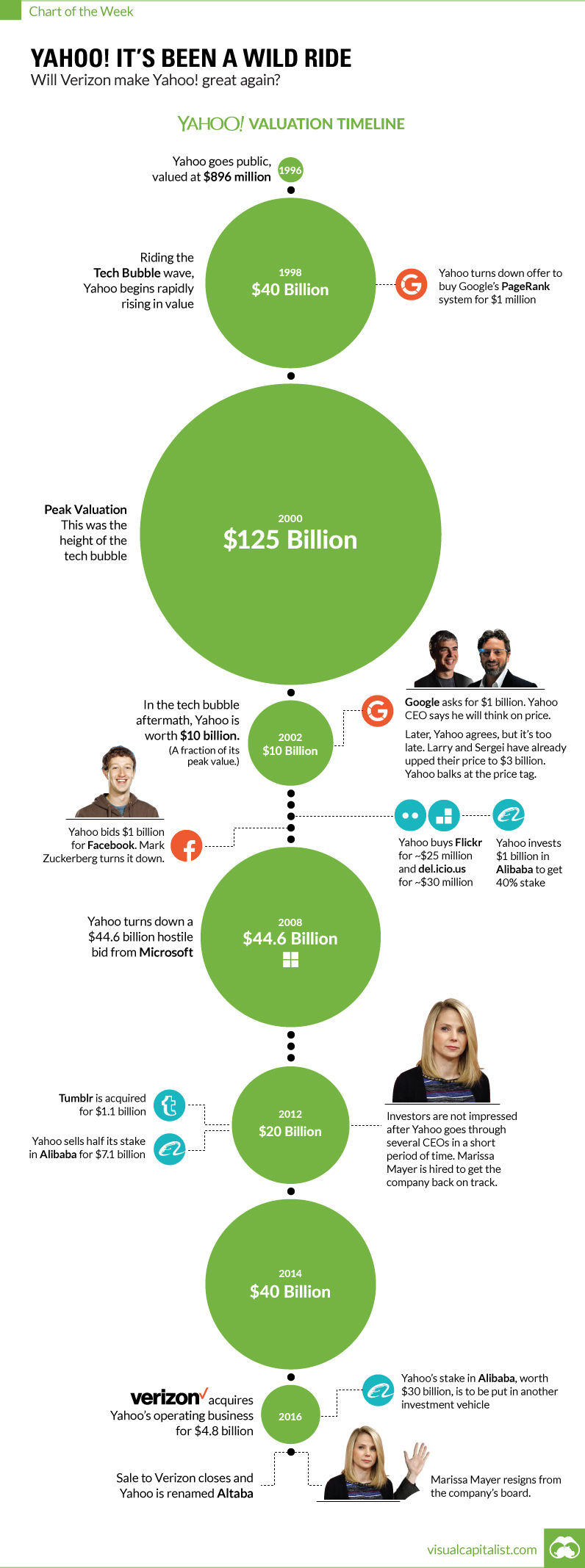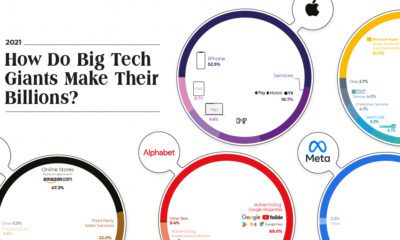Chart: The Rise and Fall of Yahoo
The 20 year roller coaster for Yahoo finally ends
The Chart of the Week is a weekly Visual Capitalist feature on Fridays. The saga surrounding one of the world’s most recognizable internet stocks has come to a close. Yahoo has finally sold its operating business to the highest bidder. The winner was Verizon – and the price was $4.8 billion. That’s worth less than 1% of the company it had multiple opportunities to buy: Google (now Alphabet).
What Happened?
Technology changes fast, and successful companies must leverage smart acquisitions in building for the future. Facebook bought Oculus Rift and Instagram, and Google bought companies like Youtube, DoubleClick, Boston Dynamics, and DeepMind to help flush out its strategy. The executives running Yahoo have a rough track record in reading industry tea leaves. It’s not just about the deals they made, but it’s also the deals they failed to make. In the end, a lack of execution with acquisitions proved to be the company’s Achilles’ Heel.
Missed Opportunities
In 1998, Yahoo was approached by two young Stanford Ph.D. students to buy their search engine algorithm. Larry Page and Sergey Brin had created PageRank – a quick way to find the most relevant website for a given search query. Yahoo skipped out on buying it for $1 million, rationalizing that it would take people off of Yahoo’s website, while decreasing traffic and ad revenues. Even later on when Google’s search business was well-established, Yahoo CEO Terry Semel balked at Larry and Sergey’s $1 billion asking price. He would eventually agree to it, but by then it was too late. The Google guys had already decided to up their price to a heftier $3 billion. Around that same time, Yahoo was turned down by a 22-year-old Mark Zuckerberg. Yahoo offered to buy Facebook for $1 billion, but Zuckerberg declined. This was a moment that billionaire Facebook investor Peter Thiel lauds as the major turning point for the company that allowed it to become the behemoth it is today. Some sources even say that if the offer was increased to $1.1 billion, that Facebook’s board would have forced Zuckerberg to take it. But it’s not just the offers made that were missed opportunities. Yahoo also turned down a hostile takeover from Microsoft in 2008 for $44.6 billion that valued the company for far more than it is worth today.
Deals that Bombed
Finally, the deals that did close were unable to add any value to the company. Yahoo famously made two acquisitions in 1999 that are now ranked by Forbes as some of the worst internet acquisitions of all-time. The first was a $4.58 billion deal for Geocities, a site that enabled users to build their own personal websites. While Geocities was a pioneer in this regard, it eventually was shuttered in 2009 after failing to deliver any value to Yahoo shareholders. The second was the famous $5.7 billion deal for Broadcast.com, an online television site that was founded by Mark Cuban. Perhaps way ahead of its time, internet connections were too slow in 1999 to run this type of video content off the web. Yahoo also bought Tumblr for $1.1 billion in 2013. While it is not ranked as one of the worst acquisitions of all time, it is not doing particularly well either.
Yahoo’s Saving Grace
There was one M&A decision that wasn’t a whiff. In 2005, the company bought a 40% stake in emerging online retail company Alibaba. The remainder of those holdings, now worth $30 billion, make up the majority of Yahoo’s market capitalization today. In the context of the recent Verizon deal, the Alibaba shares are likely being spun off into a separate investment vehicle. on But fast forward to the end of last week, and SVB was shuttered by regulators after a panic-induced bank run. So, how exactly did this happen? We dig in below.
Road to a Bank Run
SVB and its customers generally thrived during the low interest rate era, but as rates rose, SVB found itself more exposed to risk than a typical bank. Even so, at the end of 2022, the bank’s balance sheet showed no cause for alarm.
As well, the bank was viewed positively in a number of places. Most Wall Street analyst ratings were overwhelmingly positive on the bank’s stock, and Forbes had just added the bank to its Financial All-Stars list. Outward signs of trouble emerged on Wednesday, March 8th, when SVB surprised investors with news that the bank needed to raise more than $2 billion to shore up its balance sheet. The reaction from prominent venture capitalists was not positive, with Coatue Management, Union Square Ventures, and Peter Thiel’s Founders Fund moving to limit exposure to the 40-year-old bank. The influence of these firms is believed to have added fuel to the fire, and a bank run ensued. Also influencing decision making was the fact that SVB had the highest percentage of uninsured domestic deposits of all big banks. These totaled nearly $152 billion, or about 97% of all deposits. By the end of the day, customers had tried to withdraw $42 billion in deposits.
What Triggered the SVB Collapse?
While the collapse of SVB took place over the course of 44 hours, its roots trace back to the early pandemic years. In 2021, U.S. venture capital-backed companies raised a record $330 billion—double the amount seen in 2020. At the time, interest rates were at rock-bottom levels to help buoy the economy. Matt Levine sums up the situation well: “When interest rates are low everywhere, a dollar in 20 years is about as good as a dollar today, so a startup whose business model is “we will lose money for a decade building artificial intelligence, and then rake in lots of money in the far future” sounds pretty good. When interest rates are higher, a dollar today is better than a dollar tomorrow, so investors want cash flows. When interest rates were low for a long time, and suddenly become high, all the money that was rushing to your customers is suddenly cut off.” Source: Pitchbook Why is this important? During this time, SVB received billions of dollars from these venture-backed clients. In one year alone, their deposits increased 100%. They took these funds and invested them in longer-term bonds. As a result, this created a dangerous trap as the company expected rates would remain low. During this time, SVB invested in bonds at the top of the market. As interest rates rose higher and bond prices declined, SVB started taking major losses on their long-term bond holdings.
Losses Fueling a Liquidity Crunch
When SVB reported its fourth quarter results in early 2023, Moody’s Investor Service, a credit rating agency took notice. In early March, it said that SVB was at high risk for a downgrade due to its significant unrealized losses. In response, SVB looked to sell $2 billion of its investments at a loss to help boost liquidity for its struggling balance sheet. Soon, more hedge funds and venture investors realized SVB could be on thin ice. Depositors withdrew funds in droves, spurring a liquidity squeeze and prompting California regulators and the FDIC to step in and shut down the bank.
What Happens Now?
While much of SVB’s activity was focused on the tech sector, the bank’s shocking collapse has rattled a financial sector that is already on edge.
The four biggest U.S. banks lost a combined $52 billion the day before the SVB collapse. On Friday, other banking stocks saw double-digit drops, including Signature Bank (-23%), First Republic (-15%), and Silvergate Capital (-11%).
Source: Morningstar Direct. *Represents March 9 data, trading halted on March 10.
When the dust settles, it’s hard to predict the ripple effects that will emerge from this dramatic event. For investors, the Secretary of the Treasury Janet Yellen announced confidence in the banking system remaining resilient, noting that regulators have the proper tools in response to the issue.
But others have seen trouble brewing as far back as 2020 (or earlier) when commercial banking assets were skyrocketing and banks were buying bonds when rates were low.














